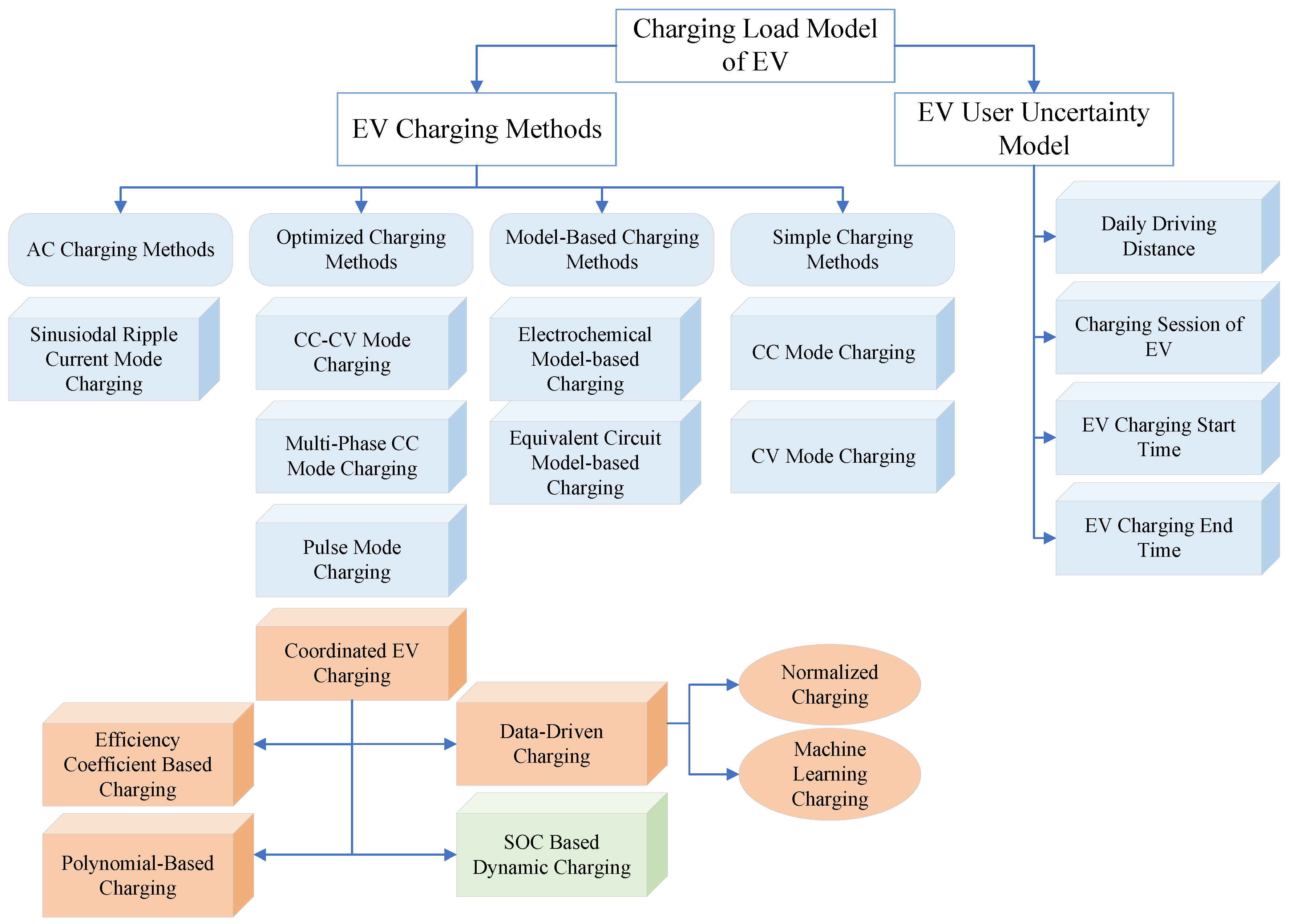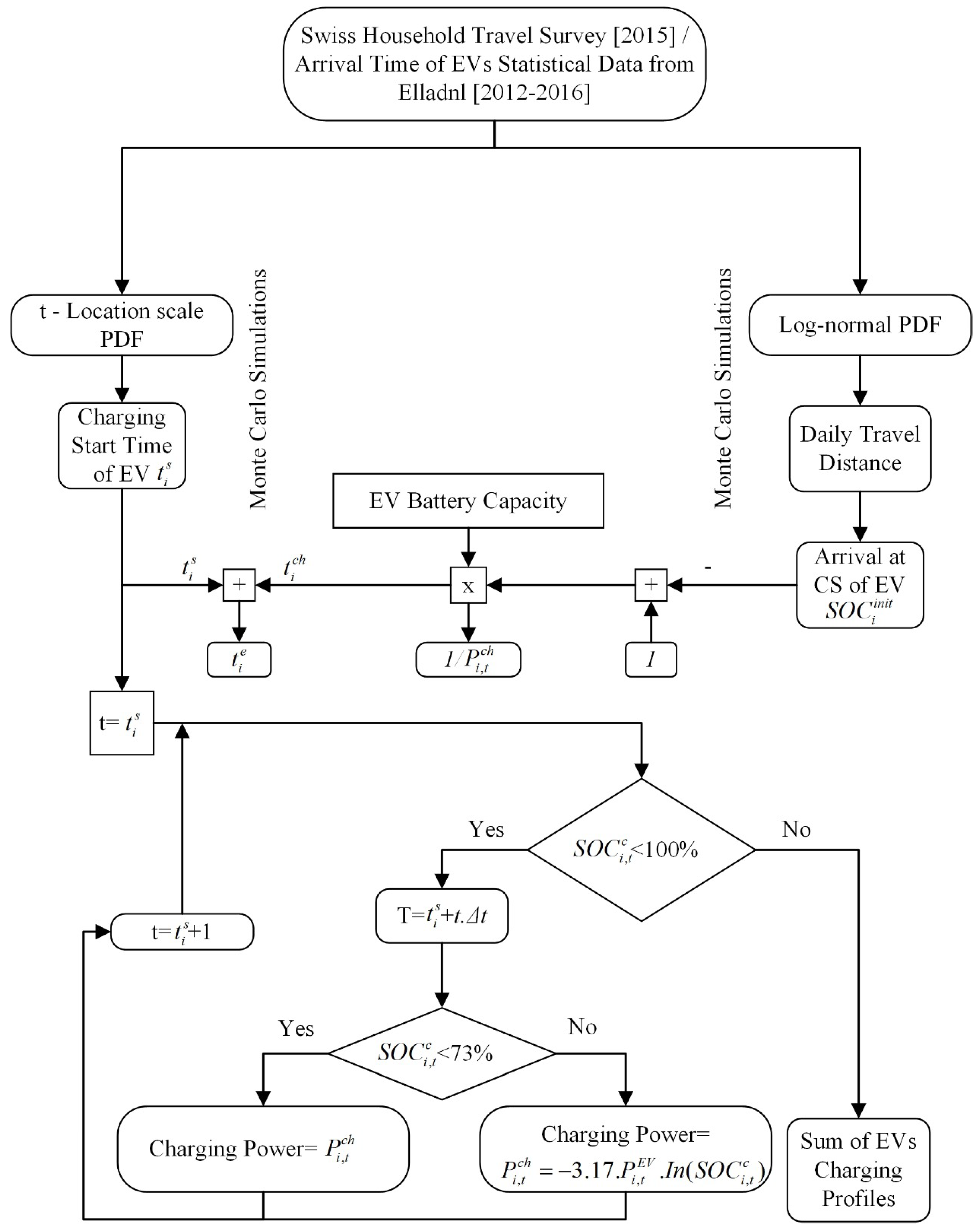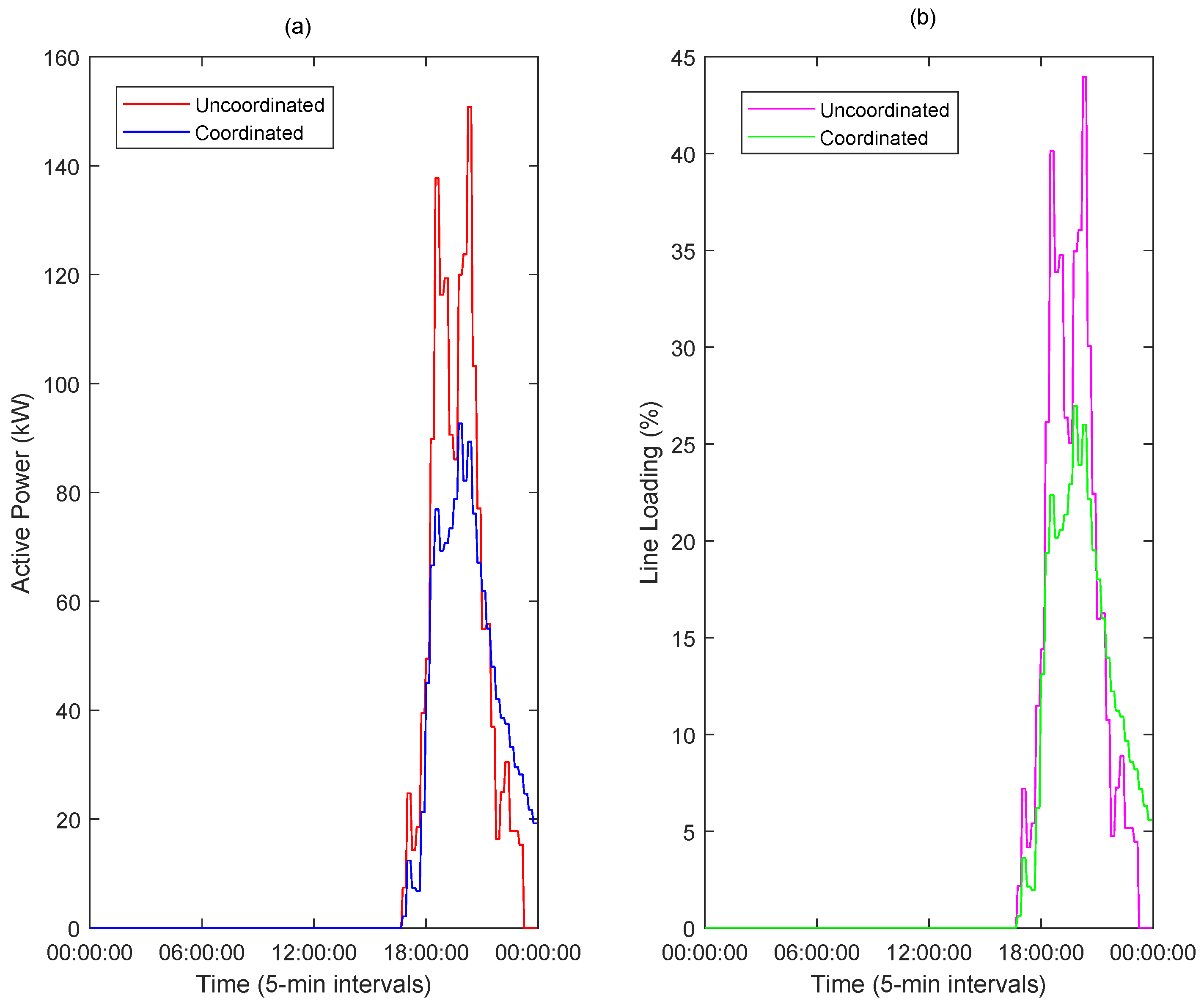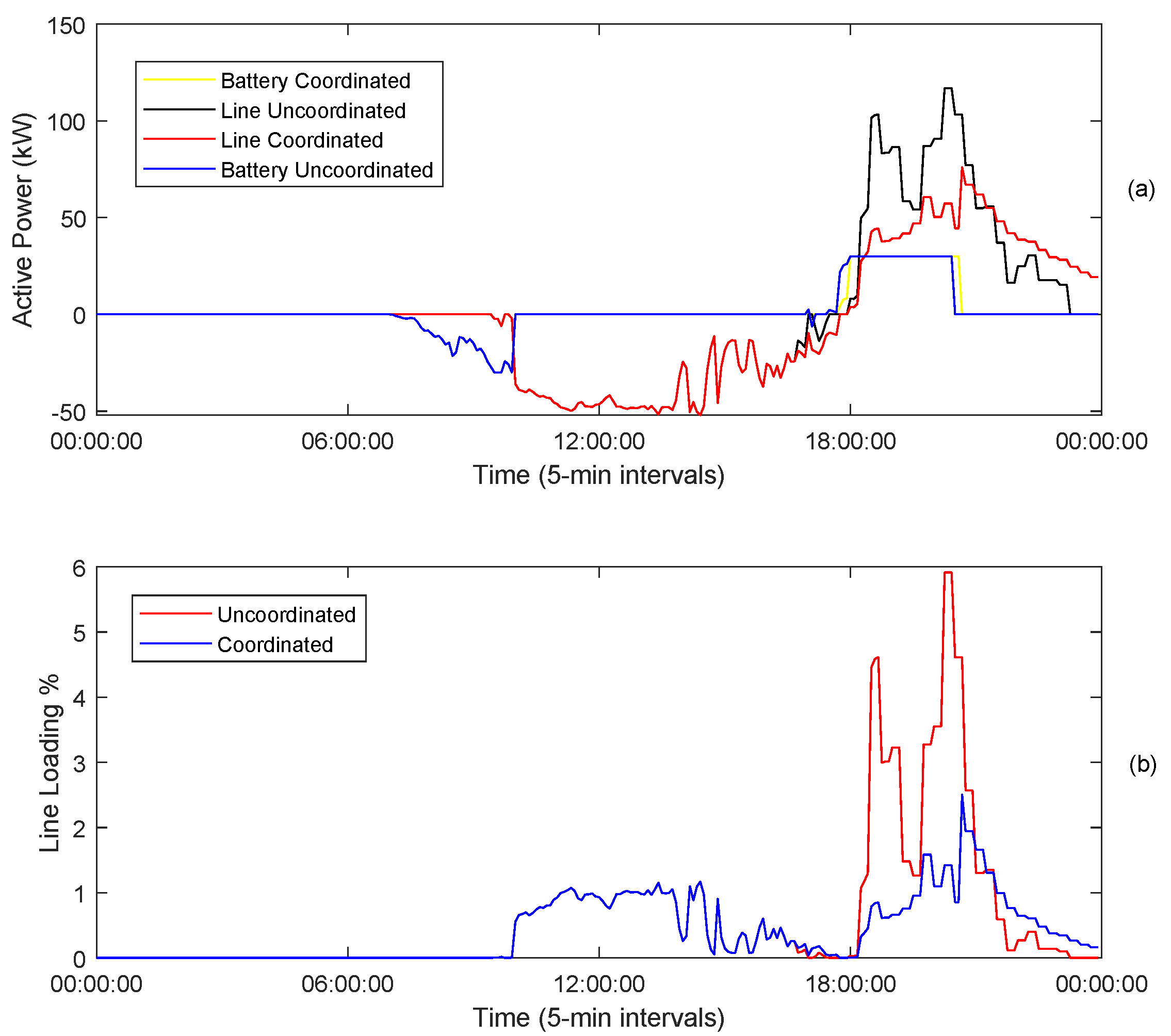The SOC Based Dynamic Charging Coordination of EVs in the PV-Penetrated Distribution Network Using Real-World Data
Abstract
:1. Introduction
- A Monte Carlo simulation with a time interval of 5 min, which holistically addresses the stochastic fit and charging load distribution of EVs in a distribution grid has been performed. A data-driven method is proposed to model the important EV charging behaviors with the dynamic SOC-based coordination method.
- A daily total EV charge-load model was created for SOC-based EV dynamic charge coordination with linear programming technique.
- It is tested on the modified Roy Billington Test System (RBTS) for the analysis of the grid effects of the specified charging load model.
- Transformer loading, transformer loss, network peak loading and line losses conditions were evaluated according to the presence of Photovoltaic (PV) and Battery Storage Unit (BSS) in the system.
2. Methodology
2.1. Varies Charging Methods for Li-ion Battery EVs
2.2. Proposed SOC-Dynamic Charging Coordination vs. Uncoordinated Charging Coordination
2.3. Real Data of EV Charging Profiles
3. Results
3.1. Results Analysis under Uncoordinated Charging and DCC Method without PV-BESS
3.2. Results Analysis under Uncoordinated and DCC EV Charging with PV-BESS
3.3. Discussion
4. Conclusions
Author Contributions
Funding
Institutional Review Board Statement
Informed Consent Statement
Acknowledgments
Conflicts of Interest
Abbreviations
| DCC | Dynamic Charge Coordination |
| SOC | State of Charge |
| RBTs | Roy Billinton Test System |
| BESS | Battery Energy Storage System |
| EV | Electric Vehicle |
| PEV | Plug-in Electric Vehicles |
| CC | Constant Current |
| CV | Constant Voltage |
| ECM | Equivalent Circuit Model |
| EM | Electrochemical Model |
| MCS | Monte Carlo Simulation |
| MG | Microgrid |
| IMG | Industrial Microgrid |
| MILP | Mixed Integer Linear Programming |
| PSO | Particle Swarm Optimization |
| GAMS | General Algebraic Modeling System |
| DC | Direct Current |
| SRC | Sinusoidal Alternating Current |
| CC-CV | Constant Current-Constant Voltage |
| SFSO | Swiss Federal Statistical Office |
| NHTS | National Household Travel Survey |
| Probability Distribution Function | |
| CDF | Cumulative Distribution Function |
| SSE | Sum Square Error |
| RMSE | Root Mean Square Error |
| Cu | Copper |
| PLR | Peak Load Reduction |
| PLL | Peak load Limitation |
| LF | Load Flattening |
| LS | Load Shifting |
| LB | Load Balancing |
| PAR | Peak to Average Ratio |
| ICD | Infrastructure Capacity Development |
| RUL | Random Uncontrollable Load |
| LP | Linear Programming |
| FL | Fuzzy Logic |
| MPC | Model Predictive Control |
| QP | Quadratic Programming |
| NLP | Non-linear Programming |
| DSL | DIgSILENT Simulation Language |
References
- Campagna, N.; Caruso, M.; Castiglia, V.; Miceli, R.; Viola, F. Energy Management Concepts for the Evolution of Smart Grids. In Proceedings of the 2020 8th International Conference on Smart Grid (icSmartGrid), Paris, France, 17–19 June 2020; Volume 2020, pp. 208–213. [Google Scholar] [CrossRef]
- Xydas, E.; Marmaras, C.; Cipcigan, L.M.; Jenkins, N.; Carroll, S.; Barker, M. A data-driven approach for characterising the charging demand of electric vehicles: A UK case study. Appl. Energy 2016, 162, 763–771. [Google Scholar] [CrossRef] [Green Version]
- Yang, Y.; Jia, Q.S.; Guan, X.; Zhang, X.; Qiu, Z.; Deconinck, G. Decentralized EV-Based Charging Optimization with Building Integrated Wind Energy. IEEE Trans. Autom. Sci. Eng. 2019, 16, 1002–1017. [Google Scholar] [CrossRef]
- Huang, Y. Day-Ahead Optimal Control of PEV Battery Storage Devices Taking into Account the Voltage Regulation of the Residential Power Grid. IEEE Trans. Power Syst. 2019, 34, 4154–4167. [Google Scholar] [CrossRef]
- Cao, Y.; Kroeze, R.C.; Krein, P.T. Multi-timescale parametric electrical battery model for use in dynamic electric vehicle simulations. IEEE Trans. Transp. Electrif. 2016, 2, 432–442. [Google Scholar] [CrossRef]
- Farmann, A.; Sauer, D.U. Comparative study of reduced order equivalent circuit models for on-board state-of-available-power prediction of lithium-ion batteries in electric vehicles. Appl. Energy 2018, 225, 1102–1122. [Google Scholar] [CrossRef]
- Lin, Q.; Wang, J.; Xiong, R.; Shen, W.; He, H. Towards a smarter battery management system: A critical review on optimal charging methods of lithium ion batteries. Energy 2019, 183, 220–234. [Google Scholar] [CrossRef]
- Ng, M.-F.; Zhao, J.; Yan, Q.; Conduit, G.J.; Seh, Z.W. Author Correction: Predicting the state of charge and health of batteries using data-driven machine learning. Nat. Mach. Intell. 2020, 2, 161–170. [Google Scholar] [CrossRef] [Green Version]
- Lahariya, M.; Benoit, D.F.; Develder, C. Synthetic data generator for electric vehicle charging sessions: Modeling and evaluation using real-world data. Energies 2020, 13, 4211. [Google Scholar] [CrossRef]
- Yong, J.Y.; Ramachandaramurthy, V.K.; Tan, K.M.; Selvaraj, J. Experimental Validation of a Three-Phase Off-Board Electric Vehicle Charger with New Power Grid Voltage Control. IEEE Trans. Smart Grid 2018, 9, 2703–2713. [Google Scholar] [CrossRef]
- Guner, S.; Kir, S. The Fuzzy-Based Smart Charging Management System for an Electric Vehicle Parking Lot Including a Roof-Top Pv System. Mugla J. Sci. Technol. 2020, 6, 18–24. [Google Scholar] [CrossRef]
- Frendo, O.; Graf, J.; Gaertner, N.; Stuckenschmidt, H. Data-driven smart charging for heterogeneous electric vehicle fleets. Energy AI 2020, 1, 100007. [Google Scholar] [CrossRef]
- Zheng, Y.; Shao, Z.; Zhang, Y.; Jian, L. A systematic methodology for mid-and-long term electric vehicle charging load forecasting: The case study of Shenzhen, China. Sustain. Cities Soc. 2020, 56, 102084. [Google Scholar] [CrossRef]
- Ganapaneni, S.; Pinni, S.V. Coordinated charging of electric vehicles including customer options for slow or fast charging. Turk. J. Electr. Eng. Comput. Sci. 2020, 28, 773–783. [Google Scholar] [CrossRef]
- Das, H.S.; Rahman, M.M.; Li, S.; Tan, C.W. Electric vehicles standards, charging infrastructure, and impact on grid integration: A technological review. Renew. Sustain. Energy Rev. 2020, 120, 109618. [Google Scholar] [CrossRef]
- Kamruzzaman, M.D. Reliability-Based Approaches to Quantify Maximum Permissible Penetration Level of Electric Vehicles in Power Systems. Ph.D. Thesis, University of Nevada, Reno, NV, USA, 2020. [Google Scholar]
- Yi, Z.; Scoffield, D.; Smart, J.; Meintz, A.; Jun, M.; Mohanpurkar, M.; Medam, A. A highly efficient control framework for centralized residential charging coordination of large electric vehicle populations. Int. J. Electr. Power Energy Syst. 2020, 117, 105661. [Google Scholar] [CrossRef]
- Chargeprice. Available online: github.com/chargeprice/open-ev-data (accessed on 1 November 2021).
- Amara-Ouali, Y.; Goude, Y.; Massart, P.; Poggi, J.M.; Yan, H. A review of electric vehicle load open data and models. Energies 2021, 14, 2233. [Google Scholar] [CrossRef]
- Akil, M.; Dokur, E.; Bayindir, R. Energy Management for EV Charging Based on Solar Energy in an Industrial Microgrid. In Proceedings of the 2020 9th International Conference on Renewable Energy Research and Application (ICRERA), Glasgow, UK, 27–30 September 2020; pp. 489–493. [Google Scholar] [CrossRef]
- Welzel, F.; Klinck, C.F.; Pohlmann, Y.; Bednarczyk, M. Grid and user-optimized planning of charging processes of an electric vehicle fleet using a quantitative optimization model. Appl. Energy 2021, 290, 116717. [Google Scholar] [CrossRef]
- Akil, M.; Dokur, E.; Bayindir, R. Impact of electric vehicle charging profiles in data-driven framework on distribution network. In Proceedings of the 2021 9th International Conference on Smart Grid (icSmartGrid), Setubal, Portugal, 29 June–1 July 2021; pp. 220–225. [Google Scholar] [CrossRef]
- Deng, Q.; Feng, C.; Wen, F.; Tseng, C.-L.; Wang, L.; Zou, B.; Zhang, X. Evaluation of Accommodation Capability for Electric Vehicles of a Distribution System Considering Coordinated Charging Strategies. Energies 2019, 12, 3056. [Google Scholar] [CrossRef] [Green Version]
- Inoa, E.; Wang, J. PHEV charging strategies for maximized energy saving. IEEE Trans. Veh. Technol. 2011, 60, 2978–2986. [Google Scholar] [CrossRef]
- Perez, H.E.; Hu, X.; Dey, S.; Moura, S.J. Optimal Charging of Li-Ion Batteries with Coupled Electro-Thermal-Aging Dynamics. IEEE Trans. Veh. Technol. 2017, 66, 7761–7770. [Google Scholar] [CrossRef]
- Ali, M.U.; Zafar, A.; Nengroo, S.H.; Hussain, S.; Alvi, M.J.; Kim, H.J. Towards a smarter battery management system for electric vehicle applications: A critical review of lithium-ion battery state of charge estimation. Energies 2019, 12, 446. [Google Scholar] [CrossRef] [Green Version]
- Chen, L.R.; Wu, S.L.; Shieh, D.T.; Chen, T.R. Sinusoidal-ripple-current charging strategy and optimal charging frequency study for Li-ion batteries. IEEE Trans. Ind. Electron. 2013, 60, 88–97. [Google Scholar] [CrossRef]
- Ayoub, E.; Karami, N. Review on the charging techniques of a Li-Ion battery. In Proceedings of the 2015 Third International Conference on Technological Advances in Electrical, Electronics and Computer Engineering (TAEECE), Beirut, Lebanon, 29 April–1 May 2015; pp. 50–55. [Google Scholar] [CrossRef]
- Xiong, R.; Tian, J.; Shen, W.; Sun, F. A Novel Fractional Order Model for State of Charge Estimation in Lithium Ion Batteries. IEEE Trans. Veh. Technol. 2019, 68, 4130–4139. [Google Scholar] [CrossRef]
- Schlomer, G.; Reese, C.; von Appen, H.; Hofmann, L. Technische Herausforderungen und Möglichkeiten zur Steuerung des Ladeverhaltens von Elektrofahrzeugen durch intelligente Ladestationen auf Basis der DIN IEC-61851. In Proceedings of the Nachhaltige Energieversorgung und Integration von Speichern; Schulz, D., Ed.; Springer Fachmedien Wiesbaden: Wiesbaden, Germany, 2015; pp. 121–126. [Google Scholar]
- Al-Haj Hussein, A.; Batarseh, I. A review of charging algorithms for nickel and lithium battery chargers. IEEE Trans. Veh. Technol. 2011, 60, 830–838. [Google Scholar] [CrossRef]
- Liu, Y.-H.; Luo, Y.-F. Search for an Optimal Rapid-Charging Pattern for Li-Ion Batteries Using the Taguchi Approach. IEEE Trans. Ind. Electron. 2010, 57, 3963–3971. [Google Scholar] [CrossRef]
- Wang, S.C.; Liu, Y.-H. A PSO-Based Fuzzy-Controlled Searching for the Optimal Charge Pattern of Li-Ion Batteries. IEEE Trans. Ind. Electron. 2015, 62, 2983–2993. [Google Scholar] [CrossRef]
- Purushothaman, B.K.; Landau, U. Rapid Charging of Lithium-Ion Batteries Using Pulsed Currents. J. Electrochem. Soc. 2006, 153, A533. [Google Scholar] [CrossRef]
- Erdinc, O.; Tascikaraoglu, A.; Paterakis, N.G.; Dursun, I.; Sinim, M.C.; Catalao, J.P.S. Comprehensive Optimization Model for Sizing and Siting of DG Units, EV Charging Stations, and Energy Storage Systems. IEEE Trans. Smart Grid 2018, 9, 3871–3882. [Google Scholar] [CrossRef]
- Wang, X.; Karki, R. Exploiting PHEV to Augment Power System Reliability. IEEE Trans. Smart Grid 2017, 8, 2100–2108. [Google Scholar] [CrossRef]
- Pareschi, G.; Küng, L.; Georges, G.; Boulouchos, K. Are travel surveys a good basis for EV models? Validation of simulated charging profiles against empirical data. Appl. Energy 2020, 275, 115318. [Google Scholar] [CrossRef]
- Plotz, P.; Jakobsson, N.; Sprei, F. On the distribution of individual daily driving distances. Transp. Res. Part B Methodol. 2017, 101, 213–227. [Google Scholar] [CrossRef]
- Elaad NL. Available online: www.elaad.nl (accessed on 1 November 2021).
- Gao, S. Design, Analysis and Control of Vehicle-to-Grid Services. Ph.D. Thesis, The University of Hong Kong (HKU), Hong Kong, China, 2014. [Google Scholar]
- Buzna, L.; De Falco, P.; Ferruzzi, G.; Khormali, S.; Proto, D.; Refa, N.; Straka, M.; van der Poel, G. An ensemble methodology for hierarchical probabilistic electric vehicle load forecasting at regular charging stations. Appl. Energy 2021, 283, 116337. [Google Scholar] [CrossRef]
- Zhou, Y.; Li, Z.; Wu, X. The multiobjective based large-scale electric vehicle charging behaviours analysis. Complexity 2018, 2018, 1968435. [Google Scholar] [CrossRef] [Green Version]
- Su, W.; Chow, M.-Y. Performance Evaluation of an EDA-Based Large-Scale Plug-In Hybrid Electric Vehicle Charging Algorithm. IEEE Trans. Smart Grid 2012, 3, 308–315. [Google Scholar] [CrossRef]












| EV Model | Charge Power (kW) | Battery Capacity (kWh) |
|---|---|---|
| Hyundai Ioniq-E | 6.6 | 28 |
| Tesla Model 3 LR | 11.5 | 74 |
| Hyundai Kona-E | 7.2 | 64 |
| VW e-Golf | 7.2 | 35.8 |
| BMW i3 | 7.4 | 33 |
| BMW i3s | 22 | 33 |
| Chevrolet Bolt-E | 7.2 | 60 |
| Honda Clarity EV | 6.6 | 25.5 |
| AUDI e-tron | 11 | 95 |
| Nissan Leaf | 6.6 | 40 |
| Fiat 500e | 6.6 | 24 |
| Kia Soul Electric | 6.6 | 30 |
| Ford Focus Electric | 6.6 | 33.5 |
| Tesla Model S 100D | 7 | 100 |
| BYD e6 | 19.2 | 61.4 |
| Citroen e-C4 | 7.4 | 50 |
| BMW iX3 | 11 | 74 |
| Honda e | 6.6 | 28.5 |
| Audi Q4 e-tron 35 | 7.2 | 52 |
| Peugeot e-208 | 7.4 | 45 |
| Audi e-tron GTRS | 11 | 85 |
| MG MarvelR | 11 | 70 |
| BMW i4 | 11 | 80 |
| VW ID.4 1st | 11 | 77 |
| Mercedes EQA250 | 11 | 66.5 |
| Dacia Spring-E | 11 | 26.8 |
| Skoda Enyaq IV | 11 | 82 |
| Kia EV6 GT | 11 | 77.4 |
| Mitsubishi i-MiEV | 3.6 | 16 |
| Mercedes B-Class | 10 | 28 |
| EV Charging | Bus Power (kW) | Base Load (kW) | Power Loss (kW) | PV | BESS |
|---|---|---|---|---|---|
| Uncoordinated Charging | 1068.53 | 917.63 | 9.86 | No | No |
| Uncoordinated Charging | 1034.56 | 917.63 | 5.91 | Yes | Yes |
| SOC Based DCC | 843.57 | 750.84 | 3.71 | No | No |
| SOC Based DCC | 827.00 | 750.84 | 2.50 | Yes | Yes |
| Problem | Control Architecture-Programming Technique | Charging Coordination | Total EV Load Model | RES | BESS | PLR | PLL | LF | LS | LB | PAR | ICD | RUL |
|---|---|---|---|---|---|---|---|---|---|---|---|---|---|
| EV customer | Centralized | Incentive | Dynamic | − | − | − | + | − | + | − | − | + | − |
| profit and | -LP | based | Schedule | ||||||||||
| charging cost | -LINGO [14] | ||||||||||||
| Charging | Decentralized | Risk | Data | − | − | + | − | − | − | − | + | + | − |
| demand | -FL | level | -Driven | ||||||||||
| characterize | - MATLAB [2] | based | |||||||||||
| EV charging | Centralized | Dynamic | Real | + | − | − | − | − | − | + | − | − | − |
| load balance | -MPC/QP | price | time | ||||||||||
| with WT | -MATLAB [3] | based | Schedule | ||||||||||
| EV increasing | Decentralized | Machine | Statistical, | − | − | − | − | − | + | − | − | − | − |
| penetration | -QP | learning | Real World | ||||||||||
| on the grid | -Python [9] | based | Data | ||||||||||
| EV parking | Centralized | Fuzzy | Dynamic | + | − | − | − | − | − | + | − | + | − |
| lots | -LP | Logic | pricing | ||||||||||
| profit | -MATLAB [11] | based | |||||||||||
| Limited charge | Centralized | Machine | Data | − | − | + | − | + | − | − | − | + | − |
| infrastructure | -LP | learning | -Driven | ||||||||||
| capacities | -Java/R [12] | based | |||||||||||
| Maximum | Centralized | Demand | Statistical, | + | − | + | + | − | + | − | − | + | + |
| allowable EV | -LP | response | Real World | ||||||||||
| penetration | OpenDSS [16] | based | Data | ||||||||||
| Computation | Centralized | Hierarchical | Receding | − | − | + | − | + | + | − | − | + | − |
| of large-scale | -QP | horizon | |||||||||||
| EVs charging | -Python [17] | control | |||||||||||
| Grid capacity | Decentralized | Dynamic | quantitative | + | − | + | − | − | + | + | − | + | − |
| high charging | -NLP | Charging | optimization | ||||||||||
| utilization | -MATLAB [21] | Management | |||||||||||
| Accommodate | Centralized | Monte Carlo | spatio | + | + | − | − | − | + | + | + | + | − |
| Capability | -MILP | Simulation | temporal | ||||||||||
| of EV on | -C [23] | sampling | random | ||||||||||
| the grid | based | model | |||||||||||
| sizing, siting | Decentralized | Normalized | Statistical, | + | + | + | − | + | − | + | − | + | − |
| of DGs, EVCSs | -Second order | curve | Real | ||||||||||
| and BESS units | conic | based | Data | ||||||||||
| -GAMS/java [35] | |||||||||||||
| Dynamic EV | Decentralized | SOC | Statistical, | + | + | + | − | + | − | + | − | + | − |
| charging effect | -LP | Based | Real | ||||||||||
| at peak times | -MATLAB/ DSL | DCC | Data | ||||||||||
| Future work: | Decentralized | SOC | Statistical, | + | + | + | − | + | − | + | − | + | + |
| dynamic EV | -LP | Based | Real | ||||||||||
| charging effect | -MATLAB/ DSL | DCC | Data |
Publisher’s Note: MDPI stays neutral with regard to jurisdictional claims in published maps and institutional affiliations. |
© 2021 by the authors. Licensee MDPI, Basel, Switzerland. This article is an open access article distributed under the terms and conditions of the Creative Commons Attribution (CC BY) license (https://creativecommons.org/licenses/by/4.0/).
Share and Cite
Akil, M.; Dokur, E.; Bayindir, R. The SOC Based Dynamic Charging Coordination of EVs in the PV-Penetrated Distribution Network Using Real-World Data. Energies 2021, 14, 8508. https://doi.org/10.3390/en14248508
Akil M, Dokur E, Bayindir R. The SOC Based Dynamic Charging Coordination of EVs in the PV-Penetrated Distribution Network Using Real-World Data. Energies. 2021; 14(24):8508. https://doi.org/10.3390/en14248508
Chicago/Turabian StyleAkil, Murat, Emrah Dokur, and Ramazan Bayindir. 2021. "The SOC Based Dynamic Charging Coordination of EVs in the PV-Penetrated Distribution Network Using Real-World Data" Energies 14, no. 24: 8508. https://doi.org/10.3390/en14248508
APA StyleAkil, M., Dokur, E., & Bayindir, R. (2021). The SOC Based Dynamic Charging Coordination of EVs in the PV-Penetrated Distribution Network Using Real-World Data. Energies, 14(24), 8508. https://doi.org/10.3390/en14248508






